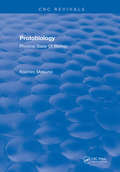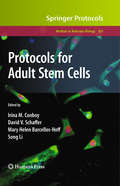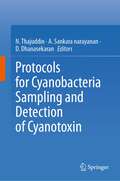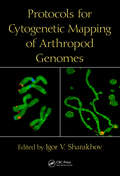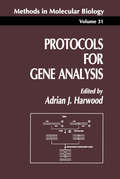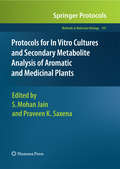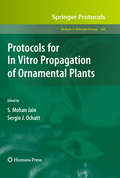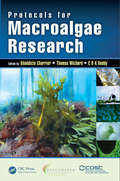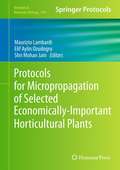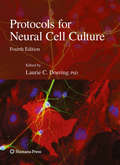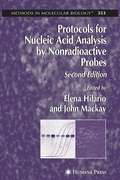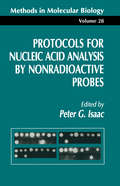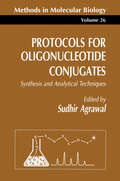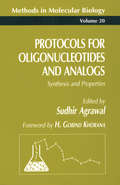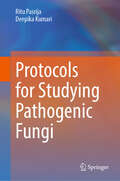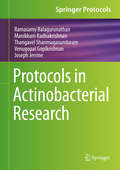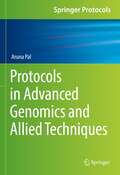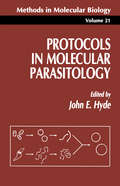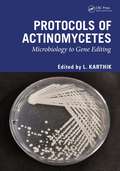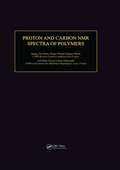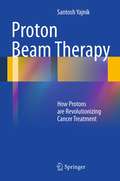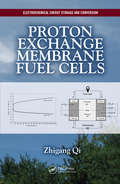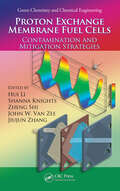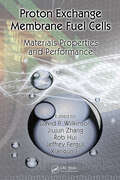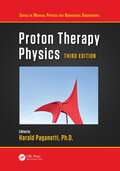- Table View
- List View
Protobiology Physical Basis Of Biology
by K. MatsunoProtobiology as a physics of becoming emphasizes the dynamics underlying conservation laws, whereas the physics of being emphasize the dynamics presupposing conservation laws. Protobiology thus concerns itself with a convoluted problem of how both the law of motion and its boundary conditions develop with time without forgetting that these two are inseparable, in contrasts to the physics of being that assumes separability.
Protocols for Adult Stem Cells
by Song Li Mary Helen Barcellos-Hoff Irina M. Conboy David V. SchafferThe study of adult stem cells has surged in recent years. Because they are responsible for the body's natural ability to fight diseases, heal and recover, or fail and succumb to various maladies, it has become increasingly important to adapt or devise new methods to identify and obtain these cells in quantity and purity for further study. In Protocols for Adult Stem Cells, expert researchers present a variety of methods for studying five types of clinically-relevant mammalian stems cells: mammary, nerve, skeletal muscle, endothelial and mesenchymal. Culture techniques have been optimized for managing the growth and differentiation of stem cells in vitro; as some stem cells are pluripotent, often the method is to guide the fate of such cells among the possible differentiation fates. Chapters include information that will assist researchers in obtaining, characterizing and studying these cells or adapting them to the stem cells of choice. Composed in the highly successful Methods in Molecular BiologyTM series format, each chapter contains a brief introduction, step-by-step methods, a list of necessary materials, and a Notes section which shares tips on troubleshooting and avoiding known pitfalls. Critical and cutting edge, Protocols for Adult Stem Cells is an essential guide which provides groundbreaking and novel techniques certain to redefine the field of stem cell biology.
Protocols for Cyanobacteria Sampling and Detection of Cyanotoxin
by D. Dhanasekaran N. Thajuddin A. Sankara NarayananThis protocol book provides detailed procedures for the isolation of cyanobacteria, extraction, quantification, and detection of cyanotoxins. It illustrates the sampling and processing of toxin-producing cyanobacteria in water and aquatic animal samples, detection of cyanotoxins from Anabaena, Anabaenopsis, Cylindrospermopsis, Microsystis, Microcystis, Nodularia, Nostoc, Schizotrix, Lyngbya, Raphidiopsis, Oscillatoria, Planktothrix in aquatic resources. It also covers toxicity analysis by various bioassay protocols, and in vitro and insilico analysis methods. The book also reviews the methods for cyanotoxin extraction, detection, and quantification by various tools including LC-MS/MS, HPLC, NMR, PCR, and HESI-MS/MS. A separate section is dedicated to the advanced methods in Cyanotoxin analysis including the Molecular Imprinting Method (MIM), Cellular signaling biosensor, Electrochemical sensor, Nanosensors, and screening of Polyketide synthase gene. The analysis of various toxin-producing genes like sxtA and mcy is also accounted for in this book. In a nutshell, the book gives comprehensive procedures about the basics and preliminary processes that are involved in sample collection to advanced methods incorporated into the well-explored and unexplored Cyanobacterial toxin. Consequently, this manual is useful for both beginners and advanced researchers, including postgraduate students, academicians, researchers, and scientists in the field of Cyanobacterial research.
Protocols for Cytogenetic Mapping of Arthropod Genomes
by Igor V. SharakhovArthropods are important to worldwide agriculture, food safety, human health, and energy production. Besides their practical significance, various species represent excellent model systems for biological investigations of evolution, development, physiology, reproduction, and social interaction. For these reasons, arthropod genomics is receiving inc
Protocols for Gene Analysis
by Adrian J. HarwoodThis volume provides a set of protocols for the analysis of cloned genes. A set of techniques is described for the basic manipulation and mutagenesis of the cloned sequences. The rest of the volume is organized into a collection of techniques appropriate to the analytical route to be investigated; these include genome structure, sequence variation, gene expression, and protein function. Finally, a number of methods are described to take the step from the first gene to those with which it interacts.
Protocols for In Vitro Cultures and Secondary Metabolite Analysis of Aromatic and Medicinal Plants
by Shri Mohan Jain Praveen K. SaxenaGiven the vital and far-reaching applications of medicinal plant metabolites worldwide, the quality and consistency of the products as well as the very survival of various species are of the utmost importance. In Protocols for In Vitro Cultures and Secondary Metabolite Analysis of Aromatic and Medicinal Plants, expert researchers provide detailed, step-by-step protocols for the establishment of in vitro cultures of key medicinal plants, their mass multiplication in a controlled environment, and step-wise secondary metabolite analysis, genetic transformation, large-scale metabolite production in a bioreactor, and molecular markers. In addition, many of these protocols will provide a basis for much needed efforts of in vitro germplasm conservation or cryopreservation of medicinal plant species at the brink of extinction as well as efforts to protect them from the adverse impact of rapid climatic changes. As a volume in the Methods in Molecular BiologyTM series, chapters include introductions to their respective topics, lists of the necessary materials and reagents, readily reproducible laboratory protocols, and tips on troubleshooting and avoiding known pitfalls. Comprehensive and authoritative, Protocols for In Vitro Cultures and Secondary Metabolite Analysis of Aromatic and Medicinal Plants is an ideal resource for scientists endeavoring to continue the research on this exciting natural branch of medicine.
Protocols for In Vitro Propagation of Ornamental Plants
by Shri Mohan Jain Sergio J. OchattWhile ornamental plants are produced mainly for their aesthetic value, the propagation and improvement of quality attributes such as leaf types, flower colour and fragrance, longevity and form, plant shape and architecture, and the creation of novel variation are important economic goals for the expanding ornamental industry. In Protocols for In Vitro Propagation of Ornamental Plants, leading researchers in the field compile step-wise protocols for rapid plant multiplication and in vitro storage of major commercially viable ornamental plants. Divided into two sections, Section A contains chapters mainly on micropropagation of cut and pot flowers with detailed protocols involving in vitro culture-explants, medium preparation, detailed medium table, shoot initiation and proliferation, root induction, in vitro plant hardening, and field transfer, and Section B delves into reviews on topics such as in vitro production of sweet peas, the status of transgenics in ornamental plants, in vitro conservation, the status of floriculture in Europe, azalea phylogeny, and thin cell layers. As part of the highly successful Methods in Molecular BiologyTM series, chapters include introductions to their respective topics, lists of the necessary materials, step-by-step laboratory protocols, and notes on troubleshooting and avoiding known pitfalls. Comprehensive and clear, Protocols for In Vitro Propagation of Ornamental Plants presents key techniques that will be of great use to floriculturists, researchers, commercial companies, biotechnologists, and students dealing with ornamental plants.
Protocols for Macroalgae Research
by Bénédicte Charrier Thomas Wichard C.R.K. ReddyThis book presents a wide range of tested and proven protocols relevant to a number of fields within biotechnology used in laboratory experiments in everyday phycological (seaweed) research.
Protocols for Micropropagation of Selected Economically-Important Horticultural Plants
by Shri Mohan Jain Elif Aylin Ozudogru Maurizio LambardiMicropropagation is a reliable technology applied commercially worldwide for large-scale plant multiplication, germplasm conservation, pathogen elimination, genetic manipulations and supply of selected plants. In Protocols for Micropropagation of Selected Economically-Important Horticultural Plants, well recognised researchers in the field compile step-wise protocols for rapid plant multiplication of economically-important horticultural species. The book contains 35 chapters, divided into four major sections. The first three sections (Section A, B and C) contain 29 micropropagation protocols of selected fruit and nut species, indoor and outdoor ornamental plants, cut flowers, and vegetables. In addition to the detailed protocols of in vitro shoot initiation, proliferation, root induction and acclimatization, chapters also include detailed information on medium preparation, explant selection and preparation. The six chapters of Section D cover specific reviews on pivotal topics, such as in vitro rejuvenation, synthetic seed technology, thermotherapy and meristem culture in banana, genetic transformation of pineapple, flower color somaclonal variation in torenia, and cryotherapy of horticultural crops. Moreover, as a part of the highly successful Methods in Molecular Biology series, chapters include introductions to the respective topic, lists of necessary materials, notes, and illustrative photos. Comprehensive and well-written, Protocols for Micropropagation of Selected Economically-Important Horticultural Plants offers a useful resource for horticulturists, researchers, commercial companies, plant propagators, biotechnologists and students interested in micropropagation.
Protocols for Neural Cell Culture
by Laurie C. DoeringSince the conception of this acclaimed series of volumes examining neural tissue culture, the expansion of neuroscience has continued to produce vital discoveries that utilize tissue culture methodologies. The expert contributors to the fourth edition of Protocols for Neural Cell Culture refine existing protocols and present the emerging new techniques and culture media formulations linked with the many advances in neuroscience. While highlighting updated experimental procedures for many of the classical neural tissue culture preps, the volume addresses topics such as regenerative medicine and the methods to grow and expand embryonic and adult neural stem cells. Essential techniques for the isolation, expansion, and cryopreservation of neural tissue from mouse, rat, and human sources are covered, as well as methods to assess aspects of cell function (calcium imaging) and cell death. With its detailed, step-by-step laboratory protocols, this volume provides the kind of detailed description and implementation advice that is crucial for getting optimal results. Authoritative and cutting-edge, Protocols for Neural Cell Culture, Fourth Edition continues the previous editions' tradition of exceptional quality and thorough coverage in tissue culture protocols for today's neuroscience in order to inspire researchers in the field to further explore this imperative area of study.
Protocols for Nucleic Acid Analysis by Nonradioactive Probes
by Elena Hilario John F. MackayProtocols for Nucleic Acid Analysis by Non-radioactive Probes, Second Edition provides a firm background on the basic preparative protocols required for the analysis of nucleic acids by nonradioactive methods. Presenting the methodologies using amazing new applications, this volume offers guide chapters on nucleic acid extractions, preparation of nucleic acid blots, and labeling of nucleic acids with nonradioactive haptens. New fluorescent techniques such as Real Time PCR and microarrays are also included, allowing users to get a nonradioactive protocol implemented in the laboratory with minimum adaptation required and fastest time to results. The protocols follow the successful Methods in Molecular BiologyTM series format, each offering step-by-step laboratory instructions, an introduction outlining the principles behind the technique, lists of the necessary equipment and reagents, and tips on troubleshooting and avoiding known pitfalls.
Protocols for Nucleic Acid Analysis by Nonradioactive Probes
by Peter G. IsaacThis book provides an exceptionally useful collection of tried and tested protocols for nucleic acid analysis that avoid the use of radioisotopes. Southern (i.e., DNA) and Northern (i.e., RNA) blotting protocols are covered in detail, from how to isolate good quality nucleic acids from plant and animal sources, to the use of the widest range of probe systems (involving digoxigenin, biotin, fluorescein, horseradish peroxidase labeling, and colorimetric and chemiluminescent detection). Other techniques treated in detail include hybridization in situ to chromosomes and transcribed RNA, newer and less conventional technologies, such as Randomly Amplified Polymorphic DNA (RAPD), reverse dot blots, bacterial identification using magnetic bead and dipstick assays, and nucleic acid sequence-based amplification.
Protocols for Oligonucleotide Conjugates
by Sudhir AgrawalYou will easily synthesize and analyze oligonucleotide conjugates by following the step-by-step protocols presented in this volume. These techniques are widely used by all molecular biologists and antisense researchers and find special application by pharmacologists working in new drug development and quality assurance assay.
Protocols for Oligonucleotides and Analogs
by Sudhir AgrawalLeading researchers summarize and describe their experience and techniques for synthesizing oligonucleotides and their analogs. The protocols presented cover all DNA analogs that have been studied to date and constitute the single most extensive source of knowledge about DNA chemistry available.
Protocols for Studying Pathogenic Fungi
by Ritu Pasrija Deepika KumariThis book is a compilation of protocols for conducting experiments with a variety of yeasts, including S. cerevisiae, Candida albicans, non-albicans Candida sp., Cryptococcus sp.; and molds, including Aspergillus sp., Fusarium sp., Mucor, Rhizopus. The chapters not only discuss National Committee for Clinical Laboratory Standards (NCCLS) accredited protocols but also emphasize the significance of Biosafety Level-2 (BSL-2) facilities. Subsequent chapters cover the essentials of handling, culturing, preserving, and reviving various fungal pathogens. Moreover, advanced techniques are explored, including counting colony-forming units (CFU), growth curve preparation, and microtiter plate assays. A separate chapter discusses the protocols for disc-diffusion, spot and kill-kinetics assays, addressing analyses like a checkerboard and Fractional Inhibitory Concentration (FIC) index assessments. Additionally, the book covers the formation of biofilm, capsule and melanin, fungal cell adhesion, and sterols extraction. Finally, it elaborates on the optimized impact achieved by assessing mitochondrial fitness through non-fermentable carbon.This book is relevant for mycologists and scientists working in the field, providing insights into fungal pathogens and protocols for handling different fungal species.
Protocols in Actinobacterial Research (Springer Protocols Handbooks)
by Ramasamy Balagurunathan Manikkam Radhakrishnan Thangavel Shanmugasundaram Venugopal Gopikrishnan Joseph JerrineThis comprehensive laboratory manual describes the various protocols involved in Actinobacterial research. The content is divided into fifteen major sections, each of which is further divided into sub-sections describing the respective aim, principles, materials & methods, protocol, expected results and diagrams. Readers will find essential protocols for e.g. sample collection, isolation, characterization, analysis, profiling and evaluation of Actinobacteria for various applications. Gathering all relevant protocols concerning Actinobacteria, and written by a team of experienced Actinobacterial researchers, it is the first book of its kind.
Protocols in Advanced Genomics and Allied Techniques (Springer Protocols Handbooks)
by Aruna PalThis laboratory manual includes the latest tools and techniques involved in genomic research. It starts with an introductory chapter on genomics and the various tools and applications involved. The initial chapters present protocols for basic techniques such as DNA isolation, electrophoresis, PCR, cDNA synthesis etc. The book then goes on to describe more advanced techniques such as next-generation sequencing, exome sequencing, use of RNAi, RNAseq, genome editing, single cell genomics etc. Each topic includes a brief description, information on the principles involved, materials & methods, protocol, and expected results, with diagrams and graphs. All protocols are presented in a very lucid and precise way, to make it easy for readers to follow and replicate them.
Protocols in Molecular Parasitology
by John E. HydeExperts present methods and protocols essential for understanding parasites at the molecular level. The protocols cover culturing techniques for the major experimental organisms, methods for isolating and processing nucleic acids and proteins, PCR-based protocols for parasite identification, gene isolation and mutation, antibody-based procedures, chromosome and epitope mapping, flow cytometry, RNA sequencing, and parasite transformation.
Protocols of Actinomycetes: Microbiology to Gene editing
by L. KarthikMany of the natural products have been isolated and characterized from the actinobacteria, for example polyketides, phenazines, peptides, indolocarbarbazoles, and sterols. To explore new antibiotics from actinobacteria, several bioinformatics and synthetic biology tools were developed. This book covers basics to recent protocols for drug discovery from actinobacteria.Features: Discusses the benefits of production of antibiotics and enzymes from actinomycetes in a large scale Covers the synthetic biology approach Describes the strain improvement of actinobacteria Gives information on basic isolation of actinobacteria and modern techniques Covers the applications and metabolic engineering strategies of actinomycetes This book will be helpful for the pharmaceutical industries and researchers to develop new antibiotics from actinobacteria and can be used in support of future research in drug discovery.
Proton & Carbon NMR Spectra of Polymers
by Quang Tho Pham Roger Petiaud Marie-France Llauro-Darricades Hugues WatonProton and Carbon NMR Spectra of Polymers is an updated, consolidated volume featuring the spectra published in three previous volumes, plus 150 newly derived spectra. It contains 458 NMR spectra with associated analytical notes covering acrylics, amides, dienes, ethers, olefins, siloxins, styrenes and derivatives, urethanes, vinyls, vinylidenes, and others. The spectra obtained are either 1H or 13C; extended bibliographic references are attached. Each entry provides details of the chemical structure of the analyzed sample, in addition to analytical conditions including nucleus, frequency, spectrometer, detection technique, solvent, temperature, reference, lock and, where appropriate, flip angle. The wealth of information contained in this single volume make Proton and Carbon NMR Spectra of Polymers an essential acquisition for all academic, industrial research, and analytical laboratories and libraries involved with polymer chemistry.
Proton Beam Therapy
by Santosh YajnikProton beam therapy is an emerging technology with promise of revolutionizing the treatment of cancer. While nearly half of all patients diagnosed with cancer in the US receive radiation therapy, the majority is delivered via electron accelerators, where photons are used to irradiate cancerous tissue. Because of the physical properties of photon beams, photons may deposit energy along their entire path length through the body. On the other hand, a proton beam directed at a tumor travels in a straight trajectory towards its target, gives off most of its energy at a defined depth called the Bragg peak, and then stops. While photons often deposit more energy within the healthy tissues of the body than within the cancer itself, protons can deposit most of their cancer-killing energy within the area of the tumor. As a result, in the properly selected patients, proton beam therapy has the ability to improve cure rates by increasing the dose delivered to the tumor and simultaneously reduce side-effects by decreasing the dose to surrounding tissue. The benefits of proton beam therapy in delivering a lethal hit to the target while sparing surrounding normal tissues from radiation are becoming applicable to an increasing number of patients and a growing list of conditions. In this book, the author will guide the reader through existing evidence supporting proton beam therapy for pediatric cancer, prostate cancer, lung cancer, brain tumors, spinal tumors, and several other conditions. The book will discuss which conditions are suitable for treatment with proton beam therapy, how the treatment is delivered, and the current data supporting its use.
Proton Exchange Membrane Fuel Cells (ISSN)
by Zhigang QiWritten by an industry-leading scientist, Proton Exchange Membrane Fuel Cells explains the theoretical foundations of PEM fuel cells in relation to practical design and operation to not only help beginners grasp the essentials, but also guide industry professionals in tackling technical challenges. Useful to scientists, researchers, students, academics, and practicing engineers, the book covers the fundamentals, materials, components, modules, system architecture, applications, and current developmental status; offers real-world examples; and provides insight into advancing this sustainable clean technology.
Proton Exchange Membrane Fuel Cells: Contamination and Mitigation Strategies
by Jiujun Zhang Hui Li Shanna Knights Zheng Shi John W. Van ZeeLarge-scale commercialization of proton exchange membrane fuel cell (PEMFC) technology has been hindered by issues of reliability, durability, and cost, which are all related to the degradation of fuel cell performance. This degradation often has root causes in contamination from fuel, air streams, or system components. With contributions from inte
Proton Exchange Membrane Fuel Cells: Materials Properties and Performance (Green Chemistry and Chemical Engineering)
by Jiujun Zhang David P. Wilkinson Jeffrey Fergus Rob HuiA Detailed, Up-to-Date Treatment of Key Developments in PEMFC MaterialsThe potential to revolutionize the way we power our worldBecause of its lower temperature and special polymer electrolyte membrane, the proton exchange membrane fuel cell (PEMFC) is well-suited for transportation, portable, and micro fuel cell applications. But the performance o
Proton Therapy Physics (Series in Medical Physics and Biomedical Engineering)
by Harald PaganettiExpanding on the highly successful previous two editions, this third edition of Proton Therapy Physics has been updated throughout and includes several new chapters on “Adaptive Proton Therapy,” "Imaging for Planning,” “Flash Proton Therapy,” and “Outcome Modeling for Patient Selection.” Suitable for both newcomers in medical physics and more seasoned specialists in radiation oncology, this book provides an in‑depth overview of the physics of this radiation therapy modality, eliminating the need to dig through information scattered across medical physics literature.After tracing the history of proton therapy, this book explores the atomic and nuclear physics background necessary for understanding proton interactions with tissue. The text then covers dosimetry, including beam delivery, shielding aspects, computer simulations, detector systems, and measuring techniques for reference dosimetry. Important for daily operations, acceptance testing, commissioning, quality assurance, and monitor unit calibrations are outlined. This book moves on to discussions of imaging for planning and image guidance as well as treatment monitoring. Aspects of treatment planning for single‑ and multiple‑field uniform doses, dose calculation concepts and algorithms, and precision and uncertainties for nonmoving and moving targets are outlined. Finally, the biological implications of using protons from a physics perspective as well as outcome modeling are discussed.This book is an ideal practical guide for physicians, dosimetrists, radiation therapists, and physicists who already have some experience in radiation oncology. It is also an invaluable reference for graduate students in medical physics programs, physicians in their last year of medical school or residency, and those considering a career in medical physics.Key Features:• Updated with the latest technologies and methods in the field, covering all delivery methods of proton therapy, including beam scanning and passive scattering.• Discusses clinical aspects, such as treatment planning and quality assurance.• Offers insight into the past, present, and future of proton therapy from a physics perspective.Dr. Harald Paganetti is a distinguished figure in the field of radiation oncology, serving as Professor of Radiation Oncology at Harvard Medical School and Director of Physics Research at Massachusetts General Hospital. He earned his PhD in experimental nuclear physics from the Rheinische‑Friedrich‑Wilhelms University in Bonn, Germany, in 1992.
